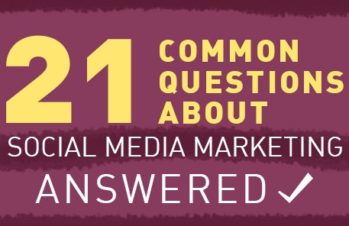Having a strategy in place when diving into the world of online marketing is totally, completely, no-questions-asked, abso-tootley posi-lutely essential. Think about it. Without a specific plan to follow, or quantifiable goals to work towards, all the time that you put into blogging, posting on social media, and emailing prospects will be a waste. How can you approach the right people in the right way at the right time, unless you have a plan in place? And how can you know if your efforts are succeeding, if you have no goals in mind?
So, yeah, it’s obvious that you need an online marketing strategy. But naturally, the next question is: Where can I get me one of those? (Sorry – but we are based in Texas, you know…)
Well, you could just make one up, based on what you think might work. Or, you could take a good hard look at your online marketing data up to this point, whether in Google Analytics or some other web analytics system and base your strategy on what’s been proven to work for you and what still needs fine-tuning.
The problem is that unless you’re a computer geek (and we mean that in the kindest possible way – we’re a bunch of computer geeks ourselves), the stats on Google Analytics can look pretty intimidating at first. And even once you get used to them, it can still be hard to know what to do about them. So your bounce rate is high – what does that mean as far as your strategy is concerned? How can you use heat map reporting to plan future marketing activities? And what can your traffic sources tell you about where you should be spending your time online?
Guess what? We at Zen Media are here to help! So buckle up, because we’re taking you for a ride through our 26 tips for using web analytics to guide your online marketing strategy.
1. Identify your conversion goals first. What exactly does “conversion” mean to you here? Maybe you want sales – okay, good. But maybe you’re after email addresses instead, or likes on Facebook, or something entirely different. That’s fine, too – but you need to define what you want up front, so you know what you’re aiming for in your strategy.
2. Define your target profiles. Next, you want to figure out who it is you’re targeting with your online marketing efforts. Not just “women,” but “married women with kids, between the ages of 30 and 45, who make over $50,000 a year, and enjoy animals.” Come up with at least three different profiles of your ideal customers, and then research where those people hang out online, and what speaks to them.
3. Be flexible and willing to change. Right off the bat, we’re just gonna put it out there – you’ve got to be willing to make changes based on what you see in your analytics. And not just once, but every single time you see something that needs to be acted on. Creating a strategy is not a one and done-type thing – your strategy will need constant tweaking.
4. Don’t expect instant results. And another important point to get out of the way up front: give your strategy time. Don’t get worried if orders don’t start pouring in instantly, or no one has signed up for your webinar yet, even though you sent the email yesterday. Online marketing takes time, and by time, we mean at least one month to get things rolling, if not more. Ideally, you want to see the big picture over 3 months, 6 months, and 12 months, and make changes and decision based on that.
5. Balance your traffic sources. Okay, are you ready? Here’s your first meaty chunk of analytics-related advice. (Yum!) When you look at that pie chart (again, yum) showing which percentage of your website traffic came from, you want to take note of those different percentages, and where they came from. Ideally, you want to balance out your traffic sources so that about 40% come from search, 20% come from direct traffic, 20% from referring sites, and 10% from campaigns. If a higher percentage is finding you through searches, you’re a little too exposed to Google’s algorithm changes. If you’re getting less than 20% of your visitors from direct traffic, you need to do more offline advertising. If less than 20% of your visitors come from referring sites, you need to up your blogging outreach and social media sharing, and if less than 10% come from your campaigns, you need to rethink how you are structuring them.
6. Look at repeat visits to understand customer behavior. Now it’s time to dig a little deeper. Take a look at the repeat visitors. They’re the ones you’ve hooked, and you want to know what you did right to get them to come back. Look at the length and depth of their visits, as well as how far apart those visits were spaced, to see what they’re doing on your site. Which pages are they visiting? That will show you what they like – and what they probably want to see more of.
7. Make more pages like your most frequently visited pages. It only makes sense that if customers keep coming back for certain types of pages, you should keep them happy by creating more of the same. Those pages are the ones that have proven to be most effective for you – why wouldn’t you make more just like them? If recipes featuring your products bring people back, keep posting new ones. If your customers like to read educational content about your industry, keep it coming.
8. Look for landing pages that are not working. Here’s the opposite issue: If pages aren’t getting viewed, or landing pages for campaigns aren’t producing results, you’ve got to figure out why, and fix it. Maybe the wrong people are being targeted by your campaign – in which case you need to rethink that campaign. Or, maybe the page itself is poor – whether the content is lacking, the appearance is confusing, or there’s some other reason, you need to find out why and change it.
9. Pay attention to which traffic source provides you with visitors who stay the longest and actually buy stuff. So maybe you have a ton of traffic coming from search – but they hardly ever buy. On the other hand, you have only a few visitors coming in from your campaigns – but they always end up staying a long time and usually buy something! That is your audience. This means you need to focus on ramping up campaigns to bring in more of those buyers.
10. Check the data about abandoned carts and forms, too. Many people forget to check and see at which point people abandon their carts or stop filling out a form. Maybe once they see how much shipping is, they balk…or maybe it’s because you don’t accept Paypal…or because Paypal is your only method of payment. Maybe the form just gets annoying after the third or fourth unnecessary question. Check to see where you’re losing people, and fix it.
11. Use heat map reporting and analytics to see if your site is well-organized. Where do people click on your pages? If the design of your pages guides their eyes in the right way, they’ll find it easy to follow the path you’d like them to take, and click where you’d like them to click, to get where they want to go. But if things are too confusing, they might click around randomly for a bit, and then they’ll leave, frustrated.
12. Place effective calls to action on your pages. In connection with the above tip, if you ask a customer to do something, you want them to do just that. If they are, you’ve got it right – but if they’re not clicking or downloading or buying, your call to action needs to be tweaked.
13. Look for the money-making content on your website, and make more like it. This corresponds with tip #7, but it does move in a slightly different direction. These aren’t necessarily the pages that are visited most often – they’re the ones that lead visitors to buy, or to do whatever you want your visitors to do, whether that’s downloading something or signing up for something. If this content is converting, imitate it in your other content.
14. Make tag clouds out of your keywords to see if they’re the ones you really want. Bonus! This one is fun and useful! Take the squillions of keywords people used to find your site, go to www.wordle.net, and create a tag cloud with them. This will give you an instant visual of which words dominate your searches, and which don’t. Adjust your keyword strategy accordingly.
15. Make tag clouds out of your internal search keywords, too! You can do the same thing to see what people have been looking for on your site, and then use that info to create new products, or to spark blog ideas.
16. Quick Check: Do your conversions correspond with the stated goals of your business? Take a look at what you’re striving for online, and whether it matches up with your real-world goals for your company. Getting Facebook likes is all well and good, but if it’s not leading to more sales of your gadgets, and that’s your goal, then you need to rethink what you consider a conversion online.
17. Look at your conversions campaign by campaign to save money. Don’t lump all campaigns together when looking at which ones produced results. Instead, inspect each one separately. Maybe Twitter is going gangbusters, but Facebook is just meh. Save money by cutting the campaigns that aren’t working, and focusing your efforts on the ones that are.
18. Find the exit points in your structured path analysis. Maybe visitors come to your site, read a blog post or two, and then leave. Or maybe they read a blog post, read your “About Me” page, look at your products for a few seconds, and then leave. If they’re leaving without buying, you want to know why. Which page lost their interest? Find it and fix it.
19. Check for unknown unknowns in your data. Check for alerts in your analytics. If there was an unexplained spike or dip in your activity, try to figure out why. What was happening during that time period? And how can you avoid or recreate that later?
20. Be sure to tag your campaigns! You want to get as much detail as possible from your analytics, so don’t just rely on a generic “Other” category to give you the goods about your campaigns. Tag each one separately, so you’ll know which is delivering and which is not.
21. Use bounce rate information to optimize pages. If people are leaving your pages, you need to fix them. Which pages make them leave? Experiment with changes in content and appearance until bounce rates are reduced.
22. Scale up your efforts acquiring the traffic sources that are doing well. If you’re getting a lot of people from your campaigns, start working those campaigns even harder to get more folks to come to your site. Same goes for referral sites, or even search, if you’re building that up as a source.
23. If a traffic source isn’t providing enough visitors, change your approach. If you aren’t getting anyone from searches, or from your campaigns, then determine what you’re doing wrong, and make those changes.
24. Check your site speed. This can often be the sole reason a visitor will get frustrated and leave, so don’t forget to double-check this metric, and fix problems if necessary.
25. Test different versions of web pages. If you’re not sure which approach to take on a certain page, try split-testing both, and then use the resulting data to decide.
26. Look at how everything you do online interacts with everything else. This may be the most important thing to keep in mind. All of your company’s online activities are integrated. Your website, your social media, your blog, your paid ads – it’s all interconnected. What you do in one place will affect what happens in the others, and vice versa. Look at your online marketing strategy as a whole, rather than as a bunch of segmented pieces, and you’ll be ahead of the game.
Well, if you made it this far, congratulations! You are obviously serious about creating the perfect online marketing strategy for your business, based on solid statistics and analytics. And don’t forget that if you ever need any help, from consulting to training to strategizing to implementation – Zen Media is here for you.







